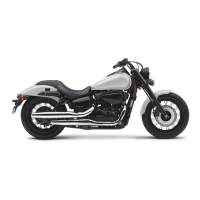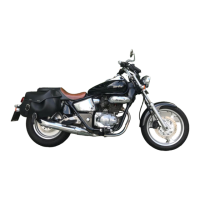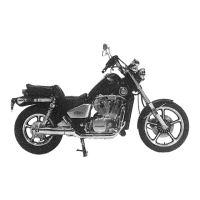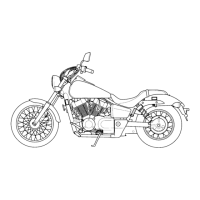
Do you have a question about the Honda Shadow Aero VT750C 2018 and is the answer not in the manual?
| Bore and Stroke | 79mm x 76mm |
|---|---|
| Compression Ratio | 9.6:1 |
| Transmission | Wide-ratio five-speed |
| Final Drive | Shaft |
| Front Suspension | 41mm fork; 4.6 inches travel |
| Front Brake | Single 296mm disc with twin-piston caliper |
| Rear Brake | Drum |
| Front Tire | 120/90-17 |
| Rear Tire | 160/80-15 |
| Wheelbase | 64.5 inches |
| Seat Height | 25.9 inches |
| Fuel Capacity | 3.7 gallons, including 0.9-gallon reserve |
| Engine Type | 745cc liquid-cooled V-twin |
| Induction | Programmed Fuel Injection (PGM-FI) |
| Rear Suspension | Dual shocks with five-position spring-preload adjustability; 3.5 inches travel |
| Trail | 6.3 inches |
| Rake | 34° |
| Curb Weight | 549 pounds (Includes all standard equipment, required fluids and full tank of fuel—ready to ride) |
Welcomes the owner and highlights belonging to a Honda family.
Emphasizes reading the manual and following safety messages.
Urges responsible maintenance and adherence to guidelines.
Stresses that safe operation is a key responsibility.
Explains DANGER, WARNING, and CAUTION signal word meanings.
Provides essential guidelines for safe riding.
Explains the importance and location of safety labels.
Details crucial safety measures for riders and passengers.
Covers break-in periods, braking, and riding conditions.
Advises against unauthorized accessories and modifications.
Provides guidance on proper motorcycle loading.
Highlights the life-saving benefits of helmets and protective apparel.
Lists pre-ride checks for rider fitness and motorcycle readiness.
Encourages practice to gain familiarity with the motorcycle.
Emphasizes situational awareness and proactive riding.
Offers tips for increasing rider visibility to others.
Advises against pushing personal abilities or riding beyond conditions.
Warns against alcohol consumption before riding.
Stresses the importance of regular maintenance for safety.
Provides guidance on actions to take if involved in an accident.
Warns about the dangers of carbon monoxide from exhaust.
Explains the purpose and importance of reading safety labels.
Details requirements for helmets, eye protection, and clothing.
Specifies suitable types of gloves for riding.
Lists essential riding attire like boots and jackets.
Outlines procedures for the initial motorcycle break-in.
Advises on proper brake usage and care.
Explains the function and operation of the Anti-lock Brake System.
Discusses engine braking and precautions for wet weather.
Provides guidance on how to safely park the motorcycle.
Details the correct method for using the side stand.
Covers recommended fuel types and safe refueling practices.
Warns about risks of unauthorized accessories and modifications.
Warns that overloading can cause crashes and serious injury.
Identifies key components in the front section of the motorcycle.
Identifies key components in the rear section of the motorcycle.
Identifies control components like levers, stands, and rear suspension.
Explains the motorcycle's display functions and readouts.
Describes how to use the select/reset button for display functions.
Provides step-by-step instructions for setting the motorcycle's clock.
Explains the meaning of indicators like ABS, PGM-FI, Coolant, and Oil.
Describes indicators for fuel reserve, turn signals, high beam, and neutral.
Details the function of handlebar-mounted switches and buttons.
Details on using the ignition switch correctly.
Describes how to engage and disengage the steering lock for security.
Outlines the correct steps to start the motorcycle's engine.
Provides troubleshooting steps for when the engine fails to start.
Lists recommended speeds for upshifting and downshifting.
Details how to open and close the fuel fill cap safely.
Explains how to use the helmet holder and its restrictions.
Warns about potential hazards of riding with a helmet attached.
Locates the document bag and tool kit for owner convenience.
Explains why regular maintenance is crucial for safety and performance.
Outlines safety precautions to be followed during maintenance tasks.
Lists recommended maintenance intervals and tasks.
Warns that improper maintenance can lead to severe accidents.
Covers general safety rules for performing maintenance.
Details maintenance tasks based on mileage or time intervals.
Explains the symbols used in the maintenance schedule table.
Details the essential checks to perform before riding the motorcycle.
Lists regular checks to ensure the motorcycle remains in good condition.
Advises on using genuine parts for reliability and safety.
Covers maintenance-free battery care and emergency procedures.
Explains cleaning battery terminals and proper battery charging methods.
Guides on how to inspect and replace blown fuses correctly.
Provides guidelines for selecting the correct engine oil.
Details checks for brake fluid, final drive oil, and coolant levels.
Covers inspecting tires for damage, wear, and pressure.
Details on checking tires for cuts, cracks, and abnormal wear.
Explains how to check tire tread depth using wear indicators.
Offers advice on following proper procedures when replacing tires.
Discusses tire lifespan and how to read the Tire Identification Number.
Instructions for replacing the air cleaner element.
Step-by-step guide for removing the motorcycle battery.
Step-by-step guide for installing the motorcycle battery.
Instructions for removing the motorcycle seat.
Instructions for installing the motorcycle seat.
Guide on how to remove the side covers.
Guide on how to install the side covers.
Explains how to inspect spark plugs for wear and deposits.
Details how to measure and adjust the spark plug gap.
Step-by-step guide to checking the engine oil level.
Instructions on how to add engine oil if the level is low.
Steps for changing the engine oil and oil filter.
Instructions for replacing the air cleaner element.
How to check the coolant level in the reserve tank.
Procedure for adding coolant if the level is low.
Recommends dealer service for changing coolant unless qualified.
How to check the final drive oil level.
Procedure for adding final drive oil if the level is low.
Steps for changing the final drive oil.
How to check the brake fluid levels in front and rear reservoirs.
Explains how to check brake pad wear indicators.
Details how to adjust the rear brake pedal height.
How to measure the freeplay in the rear brake pedal.
Steps to adjust the freeplay of the rear brake pedal.
How to check for wear on the rear brake shoes.
How to adjust the brake light switch for timely activation.
How to check the side stand's smooth operation and safety switch.
How to check for proper freeplay in the clutch lever.
Details the upper adjustment method for clutch lever freeplay.
Details the lower adjustment method for clutch lever freeplay.
Describes combining upper and lower adjustments for clutch lever freeplay.
How to check throttle smoothness and freeplay.
Steps to adjust the throttle cable freeplay.
How to clean the crankcase breather tube and drain deposits.
How to adjust the vertical aim of the headlight.
Explains how to adjust the rear suspension spring preload.
Guides for diagnosing and resolving engine starting issues.
Addresses problems related to engine overheating and coolant temp.
Explains the meaning and resolution for various warning lights.
Covers tire punctures, repair, and wheel removal procedures.
Guides for diagnosing and fixing electrical system problems.
Troubleshooting steps when the starter motor works but the engine doesn't.
Troubleshooting steps when the starter motor is not functioning.
Actions to take if the radiator fan is not working during overheating.
Procedures if the fan is operating but the engine is still overheating.
What to do if the low oil pressure indicator illuminates.
Guidance for the PGM-FI malfunction indicator lamp (MIL).
Explains problems related to the ABS indicator light.
Guidance on repairing or replacing punctured motorcycle tubes.
General procedures for removing motorcycle wheels.
Detailed steps for removing the front wheel.
Detailed steps for installing the front wheel.
Instructions for checking brake disc and bracket clearances on the front wheel.
Steps to remove mufflers for rear wheel access.
Detailed steps for removing the rear wheel.
Detailed steps for installing the rear wheel.
Instructions for reinstalling mufflers, including gasket replacement.
Troubleshooting steps if the motorcycle battery is dead.
Procedures for replacing various burned-out bulbs.
Step-by-step guide for replacing the headlight bulb.
Instructions for replacing taillight, brake light, and turn signal bulbs.
Steps for replacing the license plate light bulb.
How to inspect and replace fuses in the main fuse box.
How to locate and check the main fuse.
Specific instructions for fuse box fuses on VT750CS models.
Specific instructions for main and FI fuses on VT750CS models.
Information on ignition keys, steering lock key, and key numbers.
Details on using the ignition switch correctly.
Explains the purpose and emergency use of the engine stop switch.
Information on the read-out limits for odometer and tripmeter.
Where to find the document bag for manuals and registration.
Explains the banking sensor that stops the engine if the bike falls.
Guidelines for cleaning and washing the motorcycle.
Advises on lubricating moving parts after washing.
Specific warnings and tips for washing the motorcycle safely.
How to clean and care for aluminum parts to prevent corrosion.
Guidelines for cleaning panels and exhaust pipes.
Provides guidelines for storing the motorcycle for extended periods.
Advises on proper methods for transporting the motorcycle.
Recommends biodegradable detergents for washing.
Guidance on proper disposal and recycling of motorcycle waste.
Explains the VIN and engine serial number and their importance.
Shows the location of the engine serial number.
Details US EPA and CARB exhaust emission standards.
Outlines EPA noise emission standards for motorcycles.
Lists components of the exhaust emission control system.
Explains the programmed fuel injection system.
Describes the function of catalytic converters in reducing emissions.
Explains the closed crankcase system for emission control.
Discusses technologies to prevent fuel vapor emissions.
Prohibits tampering with the motorcycle's noise control system.
Lists actions considered tampering with emission control systems.
Symptoms indicating issues with motorcycle exhaust emissions.
Explains the function and care of catalytic converters.
Information on using oxygenated fuels and potential issues.
Lists available Honda service and owner manuals and how to order them.
Outlines the types of warranties provided for the motorcycle.
Guidance on interacting with the dealer's service department for issues.
Provides contact information for American Honda Motor Co.
Information about dealer services and the Honda Rider's Club of America.
Instructions on how to report safety defects to NHTSA and Honda.
Lists key physical and performance specifications of the motorcycle.
Details service data, tire specs, oil, fluids, and coolant.
Lists bulb types, fuse ratings, and torque values for various components.











